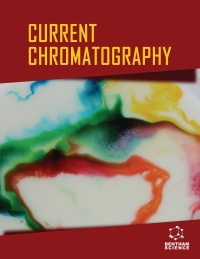- Home
- A-Z Publications
- Current Chromatography
- Previous Issues
- Volume 2, Issue 1, 2015
Current Chromatography - Volume 2, Issue 1, 2015
Volume 2, Issue 1, 2015
-
-
Identification and Quantification Methodologies for Active Substances in Natural Products: The Hole of Chromatographic and Spectroscopic Techniques
More LessThe search for new pharmacologically active compounds, whose source can be the natural products, influences the development of techniques with higher separation efficient and identification capacity. From these techniques, chromatography is the most useful and versatile one, since it may aggregate separation, isolation and identification, depending on the detection system used. For identification and structural charact Read More
-
-
-
Concerns and Considerations about the Quality Control of Natural Products Using Chromatographic Methods
More LessNatural products have been used throughout human history for many applications. The matrices of natural products show a myriad of biological activities that can result from a specific compound or from the synergistic effect of several or even hundreds of different components. Moreover, because natural products are derived from living organisms and hence are affected by biotic and abiotic factors during their production, Read More
-
-
-
Sample Stacking Coupled with Water-in-Oil Microemulsion Electrokinetic Chromatography for the Analysis of Inorganic Anions
More LessAuthors: Anastasia Kostromskikh, Andrey Pirogov, Lidia Sokolova and Oleg ShpigunFor the first time, the study describes the potentialities of a powerful preconcentration technique called fieldenhanced sample injection (FESI) combined with water-in-oil microemulsion electrokinetic chromatography (W/O MEEKC) for the quantification of inorganic anions. Water-in-oil microemulsions as background electrolytes show unique selectivities of W/O MEEKC compared to the standard capillary-electrophoresis Read More
-
-
-
Evaluation of Stationary Phases Made by Hydrosilation of Alkynes on Silica Hydride
More LessAuthors: Joseph J. Pesek, Maria T. Matyksa and Niloofar SalehiFour alkynes having a range of polarities and functional groups are bonded to a silica hydride surface via hydrosilation. The success of the reaction and characterization of the bonded material is determined by elemental analysis, diffuse reflectance infrared Fourier transform spectroscopy and solid state nuclear magnetic resonance spectroscopy. The retention properties of each of these stationary phases are evaluated by usin Read More
-
-
-
PCB Determination in a Contaminated Site: A Comparative Analytical Approach between High- and Low-Resolution GC/MS
More LessAuthors: Mauro Scaglia, Marco Bernardello, Sabrina Scolari, Paolo Rinaldi, Marika Cividati and Marco VolanteA study comparing two GC/MS analytical techniques: High Resolution (HRGC/HRMS) and Low Resolution (HRGC/LRMS) Mass Spectrometry was reported on a sample series during an investigation made for assessing PCB contamination levels on a particularly contaminated site. HRGC/HRMS is confirmed to be necessary for a correct quantification especially for Dioxin-like PCBs whereas total PCBs can be determined, with acc Read More
-
-
-
Simultaneous Determination of Fenofibrate, its Metabolite and Co- Formulated/Administered Statins Using Reverse Phase TLC-Densitometry and HPLC-UV Methods: Application in Human Plasma
More LessRapid reverse phase TLC-densitometry and HPLC-UV detection methods were developed and validated for simultaneous determination of fenofibrate (FBT), its metabolite fenofibric acid (FFA) and co-formulated/ co-administered statins; rosuvastatin (RST) or atorvastatin (AST). The first method was based on reversed phase (C18) thin layer chromatographic separation of the studied drugs followed by densitometric meas Read More
-
-
-
Theory of Multicomponent Separation Potential
More LessAuthors: Oleg Evgen’evich Aleksandrov and Vadim Maratovich GadelshinA molecular-kinetic model of a multicomponent separation process has been suggested. The expression for multicomponent separation potential (the value function) has been obtained based on the “fundamental principles”. The feature of the separation process, which leads to an infinite value of the potential for pure components, has been discussed.
-
Most Read This Month
Article
content/journals/cchg
Journal
10
5
false
en


